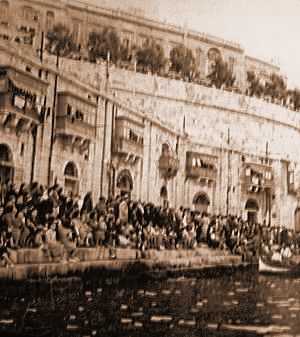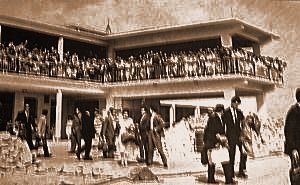The Human Aspect
Bidding farewell from quays and bastions In spite of the defence offered by Maltese Government officials responsible for chartering ships for the transport of emigrants, it was obvious that the human aspect of migration had to be respected Emigrants were not just humans to be shipped from one over-populated country to another one that had both space and need of them. The opposition in Malta's Legislative Assembly insisted that no converted ships should be chartered, but only passenger ships which had the required certificates from European authorities. It was also suggested that those passengers who were willing to pay extra money were to be allowed better accommodation if they were prepared to pay for that little bit of extra comfort. (12) Great Britain was urged to provide more financial aid to the Maltese Government so that more comfortable ships could be chartered. As Malta's Prime Minister, Dr P. Boffa, told the Legislative Assembly, more than 8,000 Maltese had settled permanently in other countries during 1948 and 1949. They did so through the help of his Ministry of Emigration. Dr Boffa reminded his listeners that his ministry had received little help from the British Government in chartering ships. Great Britain did help. On May 4, 1950, Lord Holden, Under-Secretary for Commonwealth Relations, said in the House of Lords that His Majesty's Government would soon be assisting Malta by providing financial help towards the Organisation of mass emigration from the Island. (13) Significant steps had been taken since 1947 when the Maltese had at least a partial say in the running of their own country. Ships were now regularly available and the conditions of travel would eventually improve. However, emigration cannot be assessed through abstract statistics alone. It was a very human experience which entailed physical and mental anguish. At that time the authorities both in London and in Valletta chose largely to ignore this human side of the problem. They were eager to dispatch thousands to foreign lands in order to alleviate the precarious position of Malta in the days following the end of the Second World War. The newspaper II-Berqa was not only very pro-British but it also carried consistently articles on the urgent need of mass emigration so long as that emigration was directed to the regions of the British Empire. But even such a loyalist newspaper could not ignore the anguish caused by the separation of so many Maltese from their kith and kin. This is how the departure of migrants on the Misr in 1949 was described: "On the quay there were many people waiting to see the last of their relatives and friends. Most women were in tears and the nearby road was so congested that the Police Cavalry had to be used to control the crowd. Many refused to board the ship. Many had gather near the Customs House from the early hours of the morning. At one time the police nearly lost the control of the crowd." (14) 
Luqa airport with works still in progress - watching emigrants from the spectators gallery When in later years air transport became common, scenes at the departure lounge of the airport were reminiscent of what had happened earlier on the quays. On October 15, 1964, a group of one hundred and twenty-one emigrants arrived at the airport in Luqa. There were seventy-two men, thirty-five women and fourteen children under the age of twelve. Seeing them off wasthe minister responsible for emigration, Dr Alexander Cachia Zammit. As the emigrants were being called board their airplane, one girl fainted and she had to be helped by her mother to walk to the airplane. A father, watching his son leaving, nearly jumped from the spectators gallery on to the tarmac, were it not for his other two sons and a daughter who barely managed to restrain him. Similar scenes occasionally took place at the receiving end. If the departures were marked by heart-rending separation, there were joyous reunions on the quays and at the airports. Grown up men who had lived for long periods away from their wives and children would break down and weep as they embraced their loved ones. (15) Fortunately, the saga of Maltese emigration is free from any great disasters. One exception was that concerning the migrant ship Skaubryn. But even this mishap did not entail any loss of life. Source: The Safety Valve (1997), author Fr Lawrence E. Attard, Publishers Enterprises Group (PEG) Ltd, ISBN 99909-0-081-7
    
| 

![]() .
.